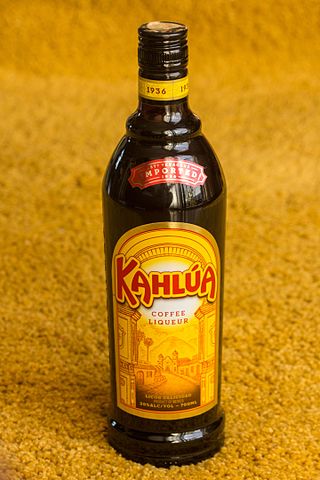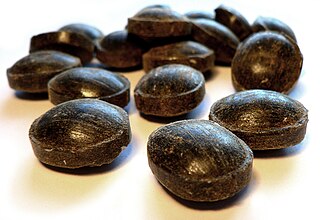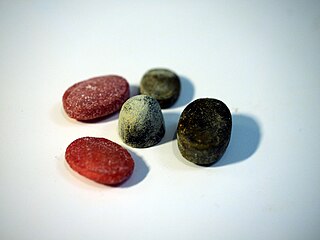

Minttu (Finnish for "mint") is a Finnish brand of peppermint-flavoured liqueur produced by Hartwall. A characteristic ingredient of the liqueur is peppermint, to give a fresh taste and aroma.


Minttu (Finnish for "mint") is a Finnish brand of peppermint-flavoured liqueur produced by Hartwall. A characteristic ingredient of the liqueur is peppermint, to give a fresh taste and aroma.
Minttu was originally developed by Chymos based on an idea from Finnish national alcohol retailer Alko. Alko had obtained a sample batch of American peppermint liqueur at a trade fair in Italy in 1986. The American developers[ who? ] had had an idea for a new, unique and exotic product, and wished to develop it in the Nordic countries, which were seen by them as a cold, far-away place. The Americans wanted the beverage to be clear in colour and have the word "schnapps" in its name. The alcohol content of the beverage had to be 100 proof, meaning 50 percent. Thus the new product would stand out among the peppermint liqueurs on the market. Alko was not interested, but it offered the production company Chymos the possibility to develop a beverage suited to the Finnish taste, while also meeting the American objectives. [1]
The new product was developed quickly and presented to the American developers, who accepted it. The engineers at Chymos wanted a round bottle, which would have been efficient to produce, but the marketing department aimed at something more special: Minttu was packaged in a rectangular bottle called a "piece of plank". The surface of the bottle was designed with a connotation of ice, to give an image of the cold Nordic countries. The label was designed by Chymos's graphic artist Aimo Vuorinen. [1]
The first setback came when the first shipload of Minttu arrived in the United States. Part of the cargo was clear as intended, but the remainder had been coloured yellow during manufacture. Chymos received crushing negative feedback, and cooperation with the American developers ended. The Americans sold off the yellow-coloured batch, at a higher price, untruthfully claiming that the yellow liqueur was of an "older vintage" and thus more expensive. [1]
The reason for the yellow colour was revealed by laboratory experiments to have been the use of iron-rich water from Lappeenranta. The problem was solved when Chymos started using distilled water. [1]
Minttu next targeted tax-free areas in Europe in both Germany and Austria, especially in the area around the Alps. Marketing of the beverage especially targeted skiing centres. The sales were helped by the strong alcohol content and the fact that the alcohol was not noticeable due to the peppermint taste. There was a jocular saying that drinking Minttu refreshed one's breath and made one's behaviour polite. [1]
Minttu entered the Finnish market in the early 1990s, and its reputation elsewhere in Europe helped boost its sales from the start. This caused problems in production, as the bottling capacity for the "piece of plank" was limited. At the most intense phase, bottling Minttu required work in two, and sometimes even three, shifts per day. It was also suggested that the rectangular bottle be replaced with a round one as originally desired by the development engineers, but the marketing department did not agree. [1]
In 1993 salty liquorice liqueur Salmiakki Koskenkorva became a competitor for Minttu, but not a major one, as the consumer targets were different. Press stories appeared about problems with young drinkers and heart disease patients because of the common effect of alcohol and the ammonium chloride in salty liquorice. Salmiakki Koskenkorva was briefly withdrawn from the market. There was also pressure on Minttu sales for the same reasons. Alko decided to continue selling Minttu, but lowered its alcohol content from 50 to 40 percent. At the same time, the word "schnapps" on the label was replaced with "liqueur". This caused sales of Minttu to drop and the beverage came into the category of "normal alcoholic drinks". Later sales of Minttu concentrated on skiing centres also in Finland. [1]

In 2009, production of Minttu moved to Pernod Ricard, which has since been developing the product family. The packaging has also been renewed by replacing the frosted ice design of the bottle with a smooth bottle. [1]
The Minttu core product line now includes six different versions: Minttu Peppermint, Minttu Choco, Minttu Black with a salty liquorice flavour, Minttu Peach, Minttu Cool Mint Choco with a chocolate milk flavour and the limited edition Minttu Cookies & Cream. [2] The Minttu Twist product line includes five versions with less alcohol and more flavour: Minttu Twist Bubble Gum, Minttu Twist Polka, Minttu Twist Karamel with a caramel flavour, Minttu Twist Cinnamon Bun and Minttu Twist Cool Banana. [2]
Minttu has established its position both in the Nordic countries and in the Baltic countries. In Finland, Minttu Peppermint has been one of Alko's best selling products for as long as Alko has been keeping records. In 2013 the beverage was at position 13 in the category "other strong drinks". [1]
In 2024, the Finnish beverage company Hartwall said it will buy its Finnish brands and their production, which also included Minttu liqueur, from the alcohol company Pernod Ricard. [3]

Kahlúa is a brand of coffee liqueur owned by the Pernod Ricard company and produced in Veracruz, Mexico. The drink contains rum, sugar, and arabica coffee.
Schnapps or schnaps is a type of alcoholic beverage that may take several forms, including distilled fruit brandies, herbal liqueurs, infusions, and "flavored liqueurs" made by adding fruit syrups, spices, or artificial flavorings to neutral grain spirits.

Finlandia is a brand of vodka produced in Finland. It is made from barley distilled into a neutral spirit in the village of Koskenkorva in Ilmajoki, operated by Finland's Altia Corporation. The distilled alcohol is then transported to a production facility in the village of Rajamäki in Nurmijärvi, about 45 kilometers north of Helsinki. In Rajamäki, the spirit is blended with glacial water, flavored, and bottled.

Pastis is an anise-flavoured spirit and apéritif traditionally from France, typically containing less than 100 g/L sugar and 40–45% ABV.

Pernod Ricard is a French company best known for its anise-flavoured pastis apéritifs Pernod Anise and Ricard Pastis. The world's second-largest wine and spirits seller, it also produces several other types of pastis.

Koskenkorva Viina is a traditional clear spirit drink (38%) in Finland, produced by Anora Group at the Koskenkorva distillery in Ilmajoki and bottled in Rajamäki, Nurmijärvi.

Tyrkisk peber is a salty liquorice candy flavoured with salmiac, produced by the Finnish company Fazer and popular in Northern Europe.

Salty liquorice, salmiak liquorice or salmiac liquorice, is a variety of liquorice flavoured with salmiak salt, and is a common confection found in the Nordic countries, Benelux, and northern Germany. Salmiak salt gives salty liquorice an astringent, salty taste, akin to that of tannins—a characteristic of red wines, which adds bitterness and astringency to the flavour. Consuming salmiak liquorice can stimulate either a savoury or non-savoury palate and response. Anise oil can also be an additional main ingredient in salty liquorice. Extra-salty liquorice is additionally coated with salmiak salt or salmiak powder, or sometimes table salt.

Becherovka, formerly Karlsbader Becherbitter, is a herbal bitters, often drunk as a digestif. It is produced in Karlovy Vary, Czech Republic by the Jan Becher company. The brand is owned by Pernod Ricard. It is made from a secret recipe based on more than twenty types of herbs and spices.

Altia Oyj was a Finnish state-owned corporation based in Helsinki, which produces, imports, exports and markets alcoholic beverages. It operates in Finland, Sweden, Norway, Denmark, Estonia and Latvia. Altia has production plants in Koskenkorva and Rajamäki in Finland and in Tabasalu in Estonia. Altia's strategy is based on two complementary cornerstones – building own brands and providing a leading Nordic and Baltic service platform for partners to develop their business. The largest imported brands are Drostdy-Hof, Two Oceans and Jack Daniel's.
Rumple Minze is a German-style liqueur brand, best known for peppermint schnapps. The brand is owned by the holding company Diageo, based in London.

Dracula Piller are a brand of salmiakki confectionery. They are very popular in Denmark and Finland.

Beefeater Gin is a brand of gin owned by Pernod Ricard and bottled and distributed in the United Kingdom. Beefeater remained in the control of its founding Burrough family until 1987. The Beefeater distillery is one of 24 in London.

In Finland, lonkero, also called long drink, refers to a ready mixed drink made from gin and, most commonly, grapefruit soda, although other long drink flavours include cranberry and lime. In Finland, lonkero is available in stores and restaurants, where it can be on draught, bottle or can.
Finnish whisky was first distilled from 1981 to 2000 at the Koskenkorva alcohol distillery in Ilmajoki, Finland, run by the state-owned alcohol monopoly Alko. After years of research and trials, the first brand to enter Finnish liquor stores was simply called Alko Whisky. In 1983 Alko introduced Viski 88 that became the best-selling whisky in Finland and remained in production until the year 2000. A 10-year-old whisky was sold from 1991, until the company discontinued all whisky production in 2000.

Ricard is a pastis, an anise and licorice-flavored apéritif, created by Marseille native Paul Ricard in 1932, who marketed it as the "true pastis from Marseille".

Chymos Oy was a Finnish company founded in 1906, producing juice, jam, wine, liqueurs and candy. In 1993 the company's candy production was bought out by Fazer, and in 2006 Chymos was fully assimilated into Cloetta Fazer.

Aakkoset is a Finnish brand of candy sold in Finland since 1970, currently sold by Cloetta under the Malaco brand name. The name "Aakkoset" comes from the various capital letters of the alphabet decorating the lozenge-shaped candies.

Hartwall Original Long Drink is a brand of long drink produced by the Finnish brewery Hartwall.